Eager: The Surprising Secret Life of Beavers
Air Date: Week of September 7, 2018
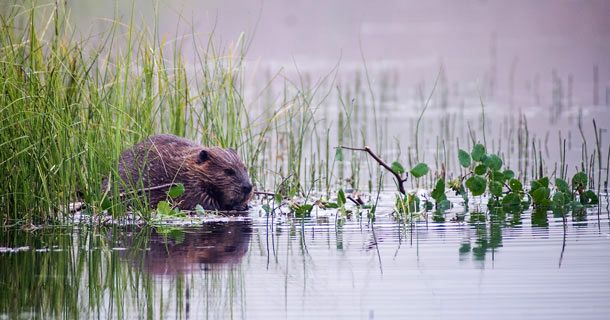
Before Europeans showed up in North America, as many as 400 million beavers swam its streams. (Photo: Sandy Brown Jensen, Flickr CC BY-SA 2.0)
The largest rodent in North America is sometimes seen as merely a pest, but a growing cohort of self-styled “beaver believers” is celebrating these toothy, dam-building creatures as a keystone species on which entire freshwater ecosystems depend. A 2018 book, Eager: The Surprising, Secret Life of Beavers and Why They Matter, takes readers up close and personal with their history, ecology and physiology. Author Ben Goldfarb spoke with Living on Earth’s Jenni Doering about why some landowners are welcoming in beavers to help store water and revitalize streams in the increasingly arid American West.
Transcript
CURWOOD: It’s Living on Earth, I’m Steve Curwood.
We may be living in the Age of the Anthropocene, but we’re not the only creatures with impressive engineering skills. One stick at a time, beavers build dams and lodges, to hold back stream water and create safe havens from predators. All that dam-building can help scores of other creatures in the process, providing more habitat for fish, birds, insects, amphibians and even moose. Ben Goldfarb is a journalist and author of the book Eager: The Surprising, Secret Life of Beavers and Why They Matter, and he spoke with Living on Earth's Jenni Doering.
DOERING: So, Ben the first hit when I Googled your name was your website with the heading, your name -- Ben Goldfarb – “Environmental Journalist, Beaver Believer”.
GOLDFARB: [LAUGHS]
DOERING: So what does it mean to be a Beaver Believer?
GOLDFARB: Yes, so the Beaver Believers are this tribe of scientists and land managers and farmers and ranchers, really anyone who believes that restoring these little incredible ecosystem engineers -- the beaver, the North American beaver -- can help us deal with all kinds of environmental problems, that by building their dams and creating ponds and wetlands they help us store water for farms and ranches; they help filter out water pollution, improving water quality; they create habitat for the fish and wildlife that we care about. They slow down floods, they act as fire breaks, they provide all of these really valuable services for us. So, the Beaver Believers are people like me who have come to recognize that this is an incredibly important animal that we should cooperate with in landscape restoration.

A beaver dam in the Yukon Delta. These painstakingly built structures, which the rodents build to create a suitable habitat, act as “speed bumps”, slowing water down and connecting a stream with its floodplain. (Photo: Alaska Region U.S. Fish & Wildlife Service, Flickr CC BY-NC-ND 2.0)
DOERING: So, what convinced you to convert to this beaver belief?
GOLDFARB: [LAUGHS] I think like most people who love being in the outdoors, I had certainly been around beavers a fair amount. I was somewhat beaver savvy, but I didn't become a true Beaver Believer until a few years back, I was living in Washington and I met this guy named Kent Woodruff who was the director then of this group called the Methow Beaver Project in the Methow Valley in central Washington. And basically what the Methow project does is they live trap nuisance beavers, beavers that are clogging up road culverts or cutting down people's apple trees or flooding fields or what have you. And they relocate those beavers to high up in the headwaters of the Okanogan-Wenatchee National Forest in central Washington, where beavers can build dams away from people and keep water on the landscape in central Washington, which is this really this pretty dry place. So, it was being out there with Kent, this very skilled naturalist and was really good at interpreting for me just how profoundly beavers were changing this landscape. It was that experience that sort of awoke me to the incredible landscape-changing power of this rodent.
DOERING: Yeah, in the passage where you talk about Kent Woodruff and the Methow Beaver Project, you talk about this little love story between two beavers, Sandy and Chomper. What's their story?
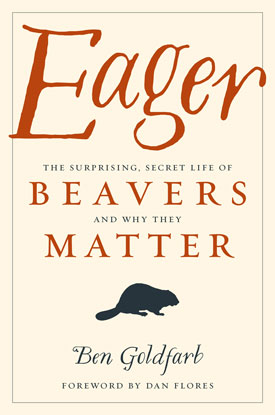
Eager: The Surprising, Secret Life of Beavers and Why They Matter is Ben Goldfarb’s first book. (Image: courtesy of Chelsea Green Publishing)
GOLDFARB: Right. So, one of the challenges of beaver relocation is that ideally you want to move entire beaver families together, right? Beavers are these very family-oriented animals. They mate for life, and if you move one beaver by itself, you know, that beaver is just going to go wandering around looking for a partner and it's probably going to get eaten by a bear or a cougar or a coyote.
DOERING: Oh no!
GOLDFARB: [LAUGHS] Yeah, that's pretty sad. And predation is one of the biggest obstacles to beaver relocation in many parts of the American West. So, ideally you can move compatible beaver couples together, that way when you relocate them, they will immediately settle down, build a dam, create a lodge, and be safe from predators and start doing the valuable work that we want them to do. So, what the Methow Beaver Project does is they basically operate this sort of rodent love motel, kind of a beaver Tinder, where they match up males and females and create compatible couples, ideally, that they can move together. So, when I visited Kent and the Methow Beaver Project, Sandy and Chomper were these two beavers who had successfully been paired up in one of the little concrete huts that they build for them, and those two beavers were successfully relocated together.
DOERING: A happy ending to that love story.
GOLDFARB: Yeah, hopefully, they're still out there doing their thing. [LAUGHS]
DOERING: [LAUGHS]
GOLDFARB: I probably should go visit them some time.

“Half-Tail Dale” awaits a mate at the Methow Beaver Project’s rodent love motel. (Photo: Ben Goldfarb)
DOERING: Well, one of things you write about in your book, Ben, is how difficult it is to tell which is the male and which is the female.
GOLDFARB: Right, yeah, beavers make things pretty difficult. So, beavers as you can understand, male beavers don't have external genitalia, right? I mean, if you're an animal that spends its life sort of swimming around logjams, you don't want too many dangling appendages that you can get snagged on things, right? So, male beavers keep it nice and tucked up which means that unless the female is lactating, there's really no way to look at a beaver and determine whether it's a male or female. So, which of course makes paring up compatible beaver couples pretty difficult, right? So, the only way you can really reliably tell without doing a DNA test is actually by smelling the beaver. So, beavers are these very scent-oriented animals and they have these couple of different sets of scent secreting glands. And basically what you do is you have to express one of these scent glands with your fingers. You kind of push on the belly until the little gland, this little mound of pink flesh pops up, and then you squeeze out a dollop of this scent secretion, and if it smells like motor oil it's a male beaver, and if it smells like cheese it's a female beaver. When I sniffed beavers with those guys, I wasn't really able to differentiate very reliably, but if you're if you're an experienced beaver sexer, you can tell males from females with pretty much 100 percent accuracy.
DOERING: Wow. Well, it sounds like a very messy job.
GOLDFARB: Yes, definitely. I think one guidebook says that you should always do this process with goggles on and your mouth closed.
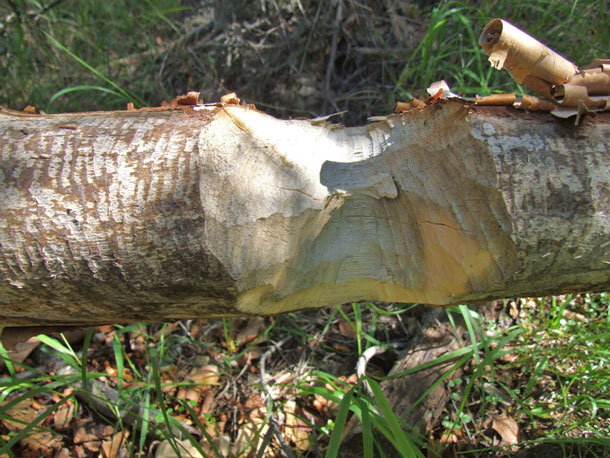
The telltale tooth marks of a beaver gnawing on a felled birch tree. (Photo: Travis, Flickr CC BY-NC 2.0)
DOERING: [LAUGHS] Oh my. It's very fun to talk about beavers. I think a lot of us understand they have big teeth, they have a big flat tail. What are some of their other amazing traits that they have?
GOLDFARB: Yeah, beavers are just so well adapted to this really unique semi-aquatic niche they occupy. They have these transparent second set of eyelids that they can close over their eyes that basically act as goggles when they're underwater. They have a second set of fur-lined lips they can close behind their teeth so they can chew and drag sticks underwater without drowning. Of course, the beaver’s tail is this amazing appendage. It kind of acts as a rudder while they're swimming, it's also a fat storage device, they actually put on fat for the winter in their tails and it acts as this sort of this thermo regulatory exchange system as well. The tail actually heats and cools them or helps regulate their body temperature. So they're just incredibly well adapted to this very unique lifestyle they have. Beavers actually have as many individual hairs on a single patch of skin the size of a postage stamp as we have in our entire head, so amazingly dense fur and, of course, that's part of what led to their downfall. You know, their fur made -- and still makes, in some places -- incredible hats, but in the end it was ultimately their demise.
DOERING: That's right. I mean, you talk about this story of how humans, white humans mostly, almost eradicated the beaver in North America. What exactly happened a couple of centuries ago when white people realized North America was just full of beavers?
GOLDFARB: Yeah, you know the first European fur traders and trappers showed up in the early 1600s and just set about trapping out beavers from every single stream, river, lake and pond they encountered. I mean, along with timber and cod that was really the most important natural resource in the new world were these amazing beaver pelts. When the first colonists arrived and the pilgrims showed up, they owed lots of money to their creditors back in Europe and the only way they could repay those debts was by shipping beaver pelts back across the Atlantic. So beavers made the Massachusetts Bay Colony possible from one standpoint. So, when Europeans first showed up there were as many as 400 million beavers in North America and by the year 1900, after three centuries of unabated trapping, their population was probably down to around 100,000 in all of North America, so just to a catastrophic collapse. Once we trapped out beavers all of those dams broke down and all of those ponds and wetlands basically drained. You read old trappers accounts and they're crossing places that we consider desert today like eastern Wyoming or parts of Utah and they're just finding ponds and wetlands and beavers everywhere, so it was once a much lusher landscape. We also drained lots of wetlands for agriculture, and of course climate change is fueling drought, so certainly trapping out beavers was certainly not the only thing contributing to drought in the American West. But we eliminated the animal that was keeping North America hydrated.
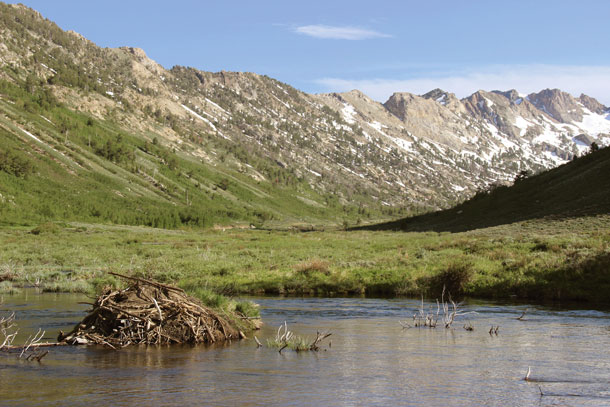
A beaver lodge in the Ruby Mountains of Nevada. (Photo: Ben Goldfarb)
DOERING: So, what do beaver ponds actually look like on the landscape, and what do they do for a stream?
GOLDFARB: In kind of a beaver rich stream, right, all of those beaver dams basically act as speed bumps: slowing the water down, spreading the water out and inundating the flood plain. I mean, connecting a stream with its floodplain is really really essential. We tend to think of streams as kind of these clear, straight, fast-moving, free-flowing channels, kind of the prototypical babbling brook. But, a system with its historic beaver population in it would look very different in a lot of respects, right? I mean, of course, beavers slow down water, they create these broad sluggish ponds and wetlands. There are dead and dying trees everywhere as rising water levels kill trees; the side channels twist all over the landscape. It looks kind of messy or chaotic. But of course, those kinds of chaotic seeming streams are in many cases healthier. Those dead trees, for example, are fantastic habitat for woodpeckers and owls and porcupines and all kinds of critters. Those inundated flood plains and meadows are great for moose and all kinds of other wild ungulates. It's a really really valuable landscape, and I think that we've forgotten that because our historical picture tends to omit beaver.
DOERING: A couple of decades ago, people were trying to bring back salmon and allow them to migrate back up to the streams where they spawn. and they looked at beaver dams and they said, whoa, how are they going to be able to navigate these structures, they’re impeding the fish from moving. How accurate is that assessment?
GOLDFARB: Yeah, you hear that a lot, that beavers create salmon barriers, and then there are places where there are environmental groups tearing out beaver dams to increase salmon passage. I mean, to me, from a common sense standpoint, clearly we once had millions or even hundreds of millions more beavers than we do today, we also had incredibly robust salmon runs. Obviously these two animals are somewhat co-adapted, right? And there's a bumper sticker that I love, which is that “beavers taught salmon to jump.” Salmon have all kinds of ways of getting around beaver dams. They can jump them, they can get swim around them during high water. Beaver dams are not like human-built concrete dams. They're not these impermeable obstacles. So, I think that fish have lots of ways of getting around beaver dams, and in fact we know that beaver dams create fantastic fish habitat. If you're a baby salmon, you don't want to live in some kind of fire hose-like main channel that's going to blow you downstream. You want some nice side channels and backwaters and pools. You want this really great diverse slow water habitat that beavers create.
DOERING: Obviously, you're a big fan of beavers, but not everyone is convinced that they are necessarily good for the landscape or that they should be entitled to live on private land and cause floods and cut down trees. What happens when beavers do that and how do the landowners respond?
GOLDFARB: Yeah. You know, look, I mean, even the most devout beaver believer is not naive about the problems that beavers can cause, right? I mean they're hard animals to live with. They're meddlers just like we are, and they do cut down valuable timber and they clog up road culverts. So, the kind of traditional response, if beavers are causing a problem, is to eliminate the beaver, right, trap the beaver out. And that can temporarily alleviate the problem, but there are kind of two issues with that approach, which is that first, I mean, of course you're eliminating the great pond and wetland habitat that beavers are creating, and second you’re really putting up a vacancy sign for the next family of beavers, right? As long as the habitat is good, the beavers will be back at some point. So, a lot of people I talked to in the book are advocates of these contraptions called flow devices which are basically these pipe and fence systems that you can use to pass water through a beaver dam or through a road culvert and kind of regulate the height of the pond that way, and sort of strike a compromise between human and rodent, where there's enough water for the beavers to persist but not so much that your road or backyard is totally submerged.
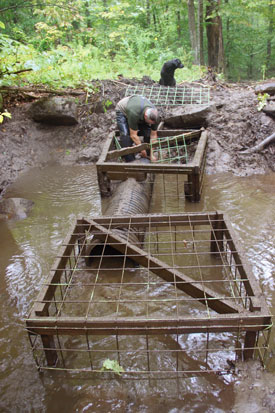
Skip Lisle does a spot of maintenance on one of his Beaver Deceivers, devices that protect roads from beaver-related flooding without having to kill the offending rodents. (Photo: Ben Goldfarb)
DOERING: And even some people who maybe initially were anti-beaver or thought, OK, if they're on my land they need to just be trapped out, like ranchers who need to grow a lot of grass for their cattle, the beavers might be flooding some of that land. You talk about some of them who actually convert from believing that they need to get rid of the beaver to saying, wait a minute, they're helping store water. Who are those people?
GOLDFARB: Yeah, that's, to me that's one of the most exciting directions in the beaver believer movement is the agricultural community, who historically has been very anti-beaver, as you say, because beavers, among other things, dam irrigation ditches and can be kind of a pain in the butt for that reason. In northeast Nevada, where one of the chapters of the book is set, there's this great cluster of ranchers where they were ranching in these very overgrazed ecosystems and they agreed to sort of reduce some of the grazing pressure and that that helped the vegetation like willow recover and that basically invited in the beavers. I think their first impulse was maybe to get rid of the beavers, but they let them stay, and beavers built dams and created these amazing ponds and wetlands and that had two great impacts. First, they're providing this great water source for cattle in this very arid northeast Nevada landscape. So, during times of drought when other ranchers actually had to truck water to their livestock because there was no water on the land, the guys, like this guy, John Griggs, had water on their landscape thanks to beavers. The other big impact is in a beaver pond there's all of the water that you can see, the visible surface water, but there's also water being forced into the ground, raising the water table and basically sub-irrigating all of these grasslands. There are ranchers who have seen fantastic grass production increases thanks to the return of beavers, and have become beaver believers for that reason as well, because if you're a rancher, grass is money.
DOERING: One complaint about beaver pond or dams in general is that all of that water that stagnant locks up and releases methane, which is a very potent greenhouse gas. What are the greenhouse gas impacts of beaver dams?
GOLDFARB: Yeah, so as you say, we do know that beaver dams, or beaver ponds, rather, release large amounts of methane. There's all of this decaying organic matter in a beaver pond, all of the leaves and sticks and insect bodies that get trapped in there, and as that stuff breaks down, we know that there is a release of methane. So, there have been studies sort of suggesting that beavers are, of course, a very minor contributor to climate change compared to all of the stuff that we humans do, but are maybe climate change contributors nonetheless, to a very small extent. However, of course, they're also sequestering lots of carbon, right? I mean, not all of that stuff is breaking down especially when the beaver pond is active and all of that organic matter is covered in water. They're actually sequestering huge amounts of carbon, and I think that one of the big findings from scientists who have studied this so far, which again is not many, is that beaver ponds, they're storing much more carbon when they're active, when the beavers are able to remain on the landscape doing their thing. What is sort of the net result of all of this carbon sequestration and methane release? We don't really know whether beavers are net positives or negatives, but there is certainly lots of research happening right now, and some of the studies I’ve seen, from places like the Colorado Rockies suggest that beavers could be pretty substantial carbon sequesters.
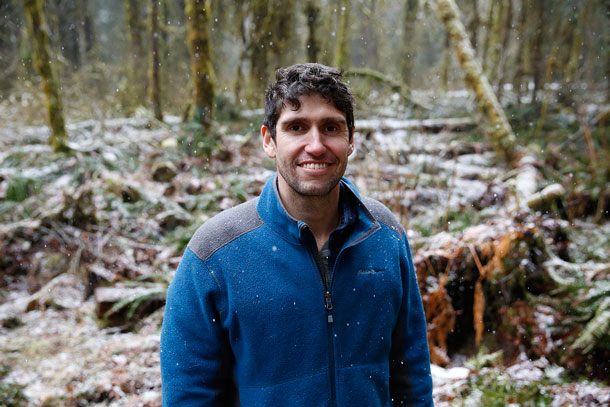
Ben Goldfarb is an environmental journalist, editor, and Beaver Believer. (Photo: Terray Sylvester)
DOERING: And, in fact, actually beavers might be able to help us cope with some of those consequences -- wildfires, heat waves, droughts. Can you talk a little bit about that?
GOLDFARB: Yeah, we know that beaver wetlands provide some degree of firebreak. There's this really wonderful pond in the Methow Valley that I visited. You know, again the Methow is this very dry place. It's been hammered with fire in the last several years, and one of the ponds there -- it was amazing -- you could see that one side of the pond had been totally scorched and the other side remained green. It was clear the fire had hit the pond and basically hadn't proceeded any further. The ability of beavers to act as firebreaks is again one of those things that hasn't really been quantified in any kind of meaningful way. As for drought, that's another thing. How much can beavers help us compensate for the loss of glacial melt and snow pack that are so important in the American West? We know that beavers can take these seasonal streams and turn them perennial. We know they're storing lots and lots of water, but how much of that water is reaching downstream users? To what extent can they compensate for some of these catastrophic climate impacts? We just don't know the answers to these questions yet. So, there's lots of beaver research happening right now all over the American West looking at beavers and climate change, and I think the next the next five to 10 years will hopefully have some really interesting results on the beavers as climate adaptation tool front.
DOERING: Ben Goldfarb is the author of "Eager: The Surprising, Secret Life of Beavers and Why They Matter". Thank you so much, Ben.
GOLDFARB: Thanks for having me. That was really fun.
CURWOOD: Author and journalist Ben Goldfarb, speaking with Living on Earth’s Jenni Doering.
Links
About Ben Goldfarb and his book Eager
Listen to our previous interview with the filmmaker of “The Beaver Believers”
About the Methow Beaver Project
Learn more about Skip Lisle’s “Beaver Deceiver” devices
Science Magazine: “What Role Do Beavers Play in Climate Change?”
Living on Earth wants to hear from you!
Living on Earth
62 Calef Highway, Suite 212
Lee, NH 03861
Telephone: 617-287-4121
E-mail: comments@loe.org
Newsletter [Click here]
Donate to Living on Earth!
Living on Earth is an independent media program and relies entirely on contributions from listeners and institutions supporting public service. Please donate now to preserve an independent environmental voice.
NewsletterLiving on Earth offers a weekly delivery of the show's rundown to your mailbox. Sign up for our newsletter today!
 Sailors For The Sea: Be the change you want to sea.
Sailors For The Sea: Be the change you want to sea.
 The Grantham Foundation for the Protection of the Environment: Committed to protecting and improving the health of the global environment.
The Grantham Foundation for the Protection of the Environment: Committed to protecting and improving the health of the global environment.
 Contribute to Living on Earth and receive, as our gift to you, an archival print of one of Mark Seth Lender's extraordinary wildlife photographs. Follow the link to see Mark's current collection of photographs.
Contribute to Living on Earth and receive, as our gift to you, an archival print of one of Mark Seth Lender's extraordinary wildlife photographs. Follow the link to see Mark's current collection of photographs.
 Buy a signed copy of Mark Seth Lender's book Smeagull the Seagull & support Living on Earth
Buy a signed copy of Mark Seth Lender's book Smeagull the Seagull & support Living on Earth

